6 Principles of Soil Health: Do Not Disturb
What is a Disturbance?
A disturbance, in this instance, refers to human or mechanical disturbance of the soil. This includes tillage and applications of synthetic fertilizer, pesticides and manure. Each of these disturbances need to be utilized with the utmost care because they have the potential to upset natural balances to the biology, chemistry and physics of the soil.
Consistent, violent soil disturbance events like tillage are not natural. On the flip side, soil health is similar to human health in that we were not meant to sit still for long periods of time. Imagine if a human was ordered not to exercise, eat, drink or excrete waste. It would not be long before their health deteriorated. So it is for the soil. Static soil becomes lifeless and unable to function. Health is maximized when the soil ecosystem finds a happy medium between routine, catastrophic disturbance and motionless inactivity. Biological disturbances in and on the soil surface are nature’s solution to this problem. This is called “bioturbation“. Think of the humble earthworm. Earthworms are constantly mixing and eating organic matter they come across on their travels. This perpetual motion, digestion and transformation of soil material is immensely beneficial for the soil.1 In addition, their movements through the soil create tunnels cemented by their excretions. This micro-compaction from earthworms is actually helpful as it creates channels for water and air to infiltrate and move through the soil profile, as well as provide a path for roots to travel with little resistance.
All told, human disturbance with machinery and chemicals often negatively affects the activity of earthworms, bacteria, fungi and all other soil organisms as they work to naturally build soil structure and improve soil functionality.
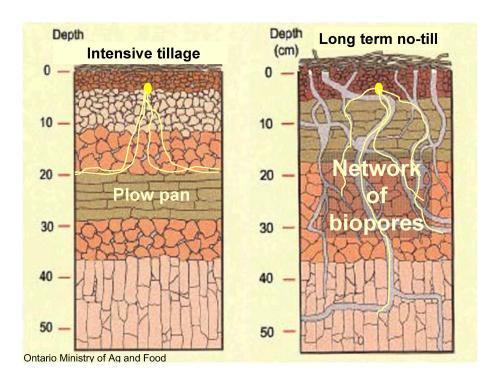
Why is Tillage Used?
One of the most common uses of tillage is to prepare a nice seedbed. Tillage prior to planting is often done to mix in past crop residue and aid in its breakdown. In addition, burying residue exposes soil to the sun to ensure that it will be warm enough and dry enough come spring planting time. Tilling the soil prior to planting also breaks the soil into finer particles, which allows for better seed-to-soil contact. Tillage is also utilized to break up crusted soils, which allows the growing plant to easily pop up through the soil surface. Breaking apart surface crusting is thought to allow water to infiltrate more efficiently. Lastly, tillage is utilized to control weeds, clearing the way for the plant of choice to have total access to sunlight, water, and nutrients. Organic producers often resort to tillage as their main method to eliminate weeds because they are not able to rely on synthetic herbicides.
Sub-surface compaction is also an issue and “subsoil” tillage is a common strategy used to break these deeper compaction layers, allowing water, air and roots to penetrate deeper into the soil profile once again.
The Harm of Tillage
Tillage negatively affects the soil by physically destroying soil structure and causing a net loss of carbon, which leads to a downward spiral of negative consequences. This spiral carries with it enough force to drag down empires.2
Let’s begin at the surface. Tillage, especially forms that invert the soil, exposes bare soil to the elements of sun, wind and rain. Water held in exposed soil readily evaporates as it is has no protection from the sun and wind. During rain events, bare soil particles are either washed away or forced closer to each other as the raindrops pound into them. Once the rain stops, sand, silt and clay particles are left floating in water on the upper surface of the soil. Sand is the biggest soil particle, so it settles first, followed by silt, and then clay.3 Clay on the uppermost layer is exposed to the sun and wind, whereby water is evaporated away and particles lock together to form a brick-like crust. Rainfall that hits this crust is not able to infiltrate, which is why tillage actually reduces a soil’s ability to infiltrate water over time.4 In fact, USDA scientists Stewart Wuest, John Williams, and Tami Johlke write that “the most important factor determining whether water will soak in or run off is the ability of the soil surface to resist slaking and reconsolidation or crusting of the soil surface.” This short demonstration by Ray Archuleta does a good job of showing the capping effect of a tilled soil.
A similar breakdown of soil structure occurs deeper down the soil profile. Channels and pockets created by biological activity are destroyed by the action of tillage, leaving much less pore space than before the tillage event. As the United States Natural Resource Conservation Agency puts it, “Tilling the soil is the equivalent of an earthquake, hurricane, tornado, and forest fire occurring simultaneously to the world of soil organisms. Simply stated, tillage is bad for the soil.”5 Imagine a town that gets hit by an earthquake, tornado, hurricane and forest fire each year, sometimes multiple times per year. The infrastructure of the town would be constantly under construction and would not be allowed to get past a certain point of development before the next natural disaster restarted the project. The town would spend much of its time, energy and money rebuilding itself rather than producing goods and services. Not to mention, many lives would be lost with each natural disaster. Most of the townspeople would pack up their bags and move once they realized they couldn’t handle the destruction any longer. So it is with the soil.6,7,8
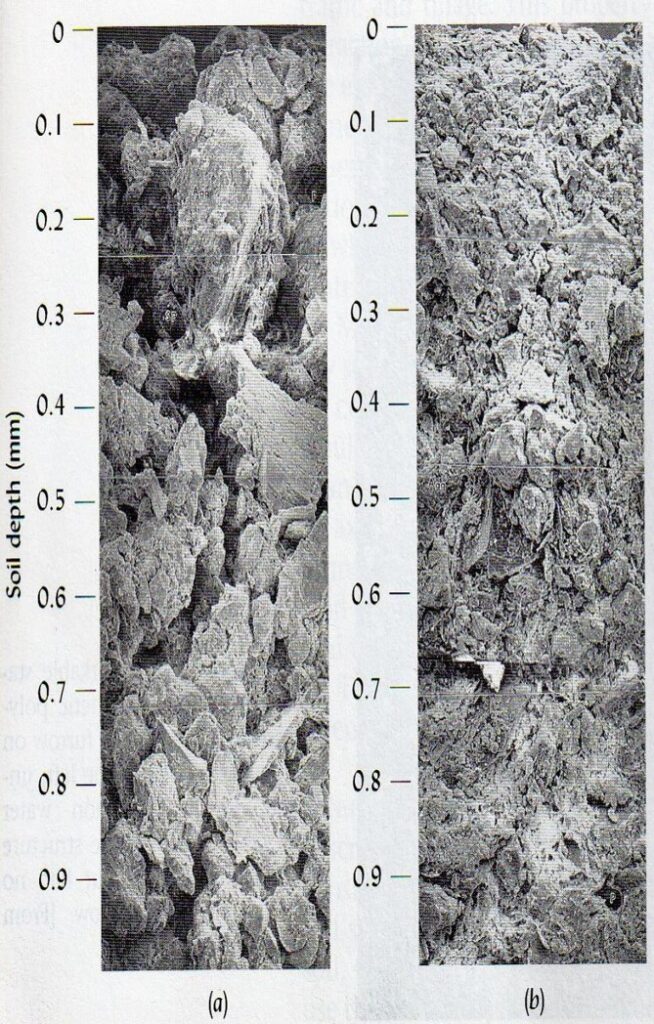
Organic matter content in the soil is also negatively affected over time by tillage.9 Packs of hungry microbes are constantly on the hunt for cellular building material and energy, a.k.a. food! These microbial packs devour any organic material in their path, such as stubble in a field after harvest. This is all well and good as it’s part of the natural cycling of nutrients. The trouble with tillage is that it physically breaks apart soil structure and exposes previously protected organic matter to the predation of microbes. Tillage also infuses oxygen into the soil, causing aerobic microbes to go into a feeding frenzy. As a result, organic matter is consumed at a furious pace, often faster than it can be produced. Much of the carbon consumed by microbes is released as carbon dioxide, which is not captured and held in the system because tillage has eliminated any growing plants above. This leads to a net loss of carbon/organic matter from the soil over time. Loss of organic matter over time in conventional tillage systems is an issue because it negatively affects many facets of soil health and land productivity, including plant available water capacity, plant available nutrients and crop yield.10
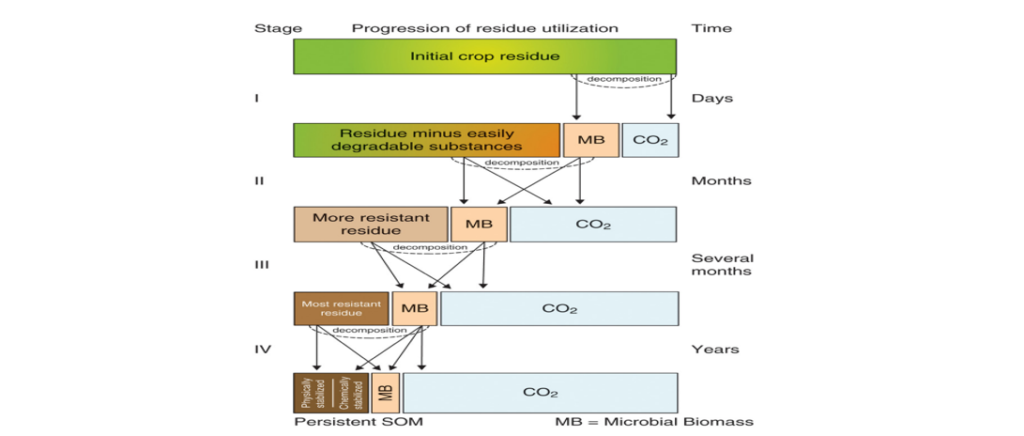
Why are Synthetic Fertilizers and Pesticides Used?
Synthetic fertilizers are applied to a field or pasture to provide a shot of nutrients that plants can uptake to survive and grow. Soil tests are often taken to determine the amount of nutrients that should be applied.
“Pesticide” is a generic term for substances that kill living organisms deemed harmful to the growth of the desired crop. “-cide” as a suffix is taken from Latin and means “a killer of”. Herbicides are applied to kill unwanted plants, insecticides kill unwanted insects, fungicides kill unwanted fungi… you get the idea. The key word in each case is “unwanted”.
The Harm of Synthetic Fertilizers and Pesticides
Nutrient cycling in the soil requires a diverse team of microbes and macroscopic organisms transforming nutrients into and out of plant-available forms. Synthetic fertilizers short-circuit this process by dumping manufactured plant-available nutrients onto the land where they can be directly absorbed. Or so we think. The 15th edition of The Nature and Properties of Soil textbook writes, “A common myth about fertilizers suggests that inorganic fertilizers applied to soil directly feed the plant, and that therefore the biological cycling of nutrients are of little consequence where inorganic fertilizers are used. The reality is that nutrients added by normal application of fertilizers, whether organic or inorganic, are incorporated into the complex soil nutrient cycles, and that relatively little of the fertilizer nutrient (from 10 to 60%) actually winds up in the plant being fertilized during the year of application. Even when the application of fertilizer greatly increases both plant growth and nutrient uptake, the fertilizer stimulates increased cycling of the nutrients, and the nutrient ions taken up by the plant come largely from various pools in the soil and not directly from the fertilizer. For example, some of the added Nitrogen (N) may go to satisfy the needs of microorganisms, preventing them from competing with plants for other pools of N.” Phosphorus absorption from fertilizers is particularly woeful as more than 80% of applied P is immediately made unavailable after application.11
Synthetic fertilizer applications slowly render biological services unnecessary as inorganic nutrient are force-fed directly to the soil system. This changes the dynamic relationship between plant and soil microbiome, leading to a decrease in soil-borne nitrogen-fixing bacteria12, the favoring of pathogenic organisms over beneficial ones13, a reduction in the plant’s immune system14, and unnatural swings in soil pH15. Over time, these large, annual applications of fertilizer decrease the ability of soil biology to make nutrients plant-available, creating a downward spiral leading to increased demand for fertilizer to produce a crop.
There also exists an environmental cost to synthetic fertilizer production and application. Research suggests that the full life cycle of fertilizers is responsible for up to five percent of global greenhouse gas emissions.16 In addition, excess nitrogen and phosphorus in waterways from agricultural runoff cause “eutrophication”, a process that causes mass deaths of aquatic organisms through increased phytoplankton growth.17 “Dead zones”, such as the one in the Gulf of Mexico covering more than 7,500 square miles at some times18, cause millions of dollars in damage to local economies each year. Someone may well write a sequel to Rachel Carson’s Silent Spring titled Still Waters.
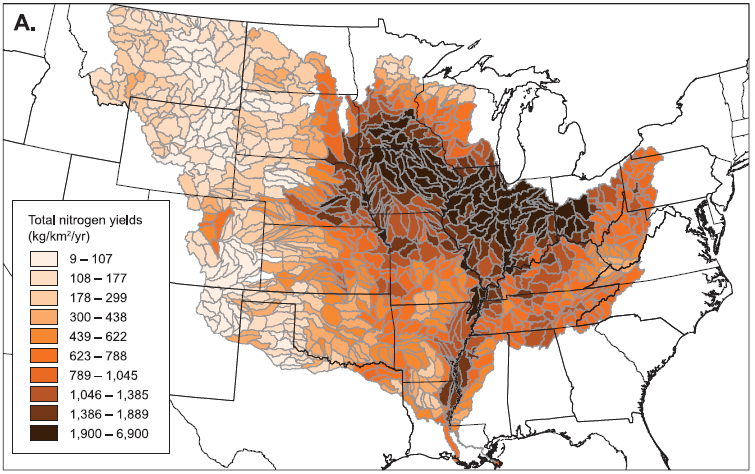
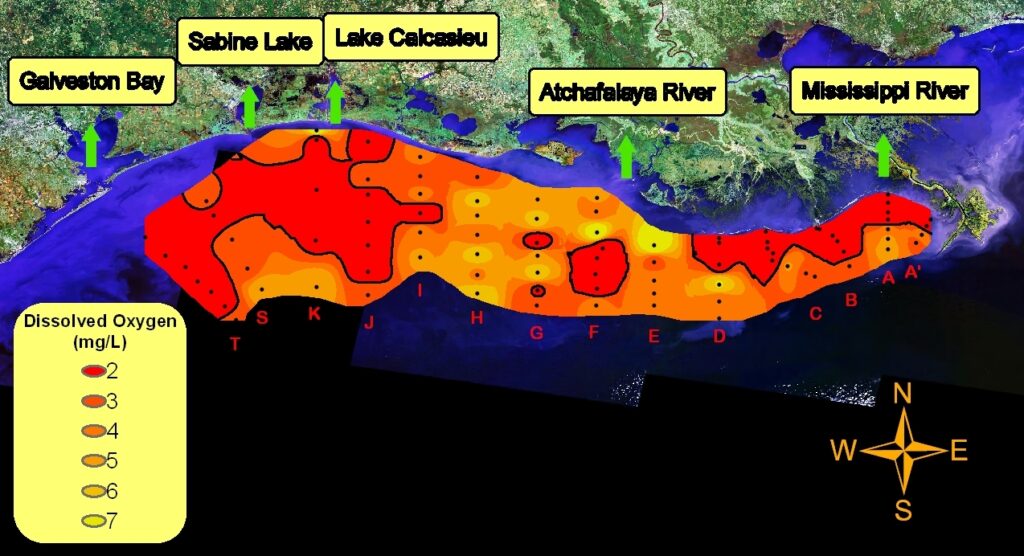
While synthetic fertilizer application can seem quite harmless on the surface, there is no getting around the toxic nature of pesticide application. After all, the purpose of these products is to weaken, damage or kill living cells. It should not come as a surprise, then, that toxic compounds in pesticides have been shown to negatively affect soil microbes19, water quality20 and even wildlife21. As for the effects on human health, one paper published in the International Journal of Cancer reviewed 63 epidemiological studies from 2017 to 2021 to see what effects exposure to pesticides had on cancer risk in humans. After reviewing the data, the authors state that, “While much of the recent evidence suggests causal relationships between pesticide exposure and cancer, the strongest evidence exists for acute myeloid leukemia (AML) and colorectal cancer (CRC), diseases in which the observed associations were consistent across several studies.”22 On the other hand, a 2021 study from the International Archives of Occupational and Environmental Health found that, “Several active ingredients were associated with specific cancer but overall, there was neither strong nor consistent epidemiologic data supportive of a positive association between pesticide exposure in occupational settings and cancer.”23 As for mental health, a 2023 systematic review of fifty-seven studies demonstrated an increased prevalence of depressive disorders in farmworkers exposed to pesticides as well as an increased self-reported prevalence of depression in this population.24 These results are not universal, however, as one review highlighted inconsistencies in linking poor mental health and pesticide use. The authors wrote that, “While some studies specifically showed that both high- and low-dose pesticide exposure were associated with poor mental health, consistent and rigorous research methods are lacking.”25 These seemingly contradictory research findings elucidate the difficulty in trying to understand the long-term effects of exposure to chemicals.
One of the lesser debated topics with pesticides is the resistance they create in populations of organisms, which scientists have known about for quite some time now. Insecticide resistance was first documented in 1908, fungicide resistance in 1940 and herbicide resistance in 1968.26 Resistance happens because the repeated use of chemicals puts selective pressure on individuals that survive the treatment. These resistant individuals survive at a higher rate and pass on their resistance-conferring genes to future generations. Unfortunately, resistance among pests is no small issue. For insects, 550 insect species have been reported as resistant to 325 insecticides and five insecticidal traits in genetically engineered plants, as of 2015.27 For fungal pathogens, Oklahoma State University reports that “fungicide resistance problems in the field have been documented for nearly 200 diseases (crop – pathogen combinations), and within about half of the known fungicide groups. Many more cases of resistance are suspected but have not been documented.”28 Last but not least, herbicide-resistant weeds are a major problem for producers. The University of Minnesota writes that, “By 1991, 120 weed biotypes were resistant to triazine herbicides and 15 other herbicide families were documented throughout the world. Since then, nearly 500 unique cases of herbicide resistance have been reported.”26

Another troubling fact about pesticides is that scores of pesticides have been approved and used for many years before they were banned for causing unintended, negative outcomes for organisms and the environment. This is largely due to the aforementioned difficulty of researching their long-term effects in a timely manner. In any case, global pesticide use rose throughout the 20th century and has seemed to level off in the 2010’s. The most recent data from 2020 shows that 2.59 million tons were applied globally.29 The fate of these chemicals is being studied rigorously and one research investigating the environmental pollution risk caused by 92 active ingredients in 168 countries showed that 64% of global agricultural land (approximately 24.5 million km2) is at risk of pesticide pollution by more than one active ingredient, and 31% is at high risk.30

So, should we be applying these pesticides to our crops and pastures if they might causing such serious problems? Once again, it depends who you ask.31,32 If nothing else, pesticides cost money and all farmers and ranchers should be trying to find ways to reduce pesticide purchases. It’s also important to remember that chemical companies make billions of dollars selling these products, and the track record of high-earning industries being honest with consumers about the dangers of their products is… shall we say… questionable at best. Even our beloved sugar is not safe from industry influence when there’s money to be had.33


Read the U.S. House of Representatives report here.
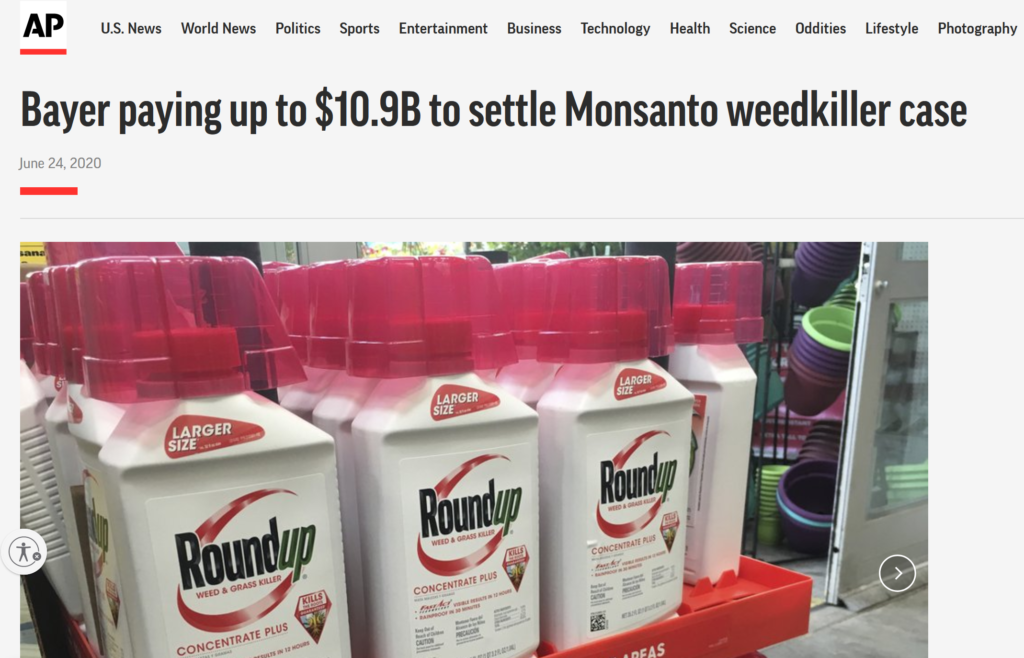
The effects of synthetic fertilizers and pesticides are obviously variable, depending upon the quantity, frequency, quality and timing of applications. Both are necessary in today’s agricultural model and a cold-turkey approach to reducing their use would be foolish. Sri Lanka’s detrimental loss of yields should be viewed as a cautionary tale as we design future agricultural systems.34 However, mounting evidence and lawsuits prove that excess fertilizer and pesticides in our environment are not desirable. We need to be minimizing these applications where possible and allow the relationships between soil, plant and animal that have developed over millennia to flourish, decreasing the need for chemical disturbances in the first place.
Why is Manure Applied?
Manure has been applied to agricultural fields as long as it has existed. Humans understood long ago that manure and urine application often led to better yields. We know now that approximately 70-80% of the nitrogen, 60-85% of the phosphorus and 80-90% of the potassium an animal consumes is excreted in their manure.35 Manure is also full of carbon-rich organic matter, thus providing benefit to overall soil health that synthetic fertilizer alone does not. Utilizing manure correctly closes a loop in agriculture by using the waste from one enterprise as an input for another.

The Harm of Manure
The harm that manure can cause is quite a tricky subject. Yes, manure applications done correctly can be very beneficial for an operation. However, we must always remember that any disturbance to the soil needs to be done carefully or it can actually move our operations in a negative direction. Manure is no different.
To start, harmful compounds may be lurking in applied animal manure, ranging from antibiotics and antibiotic resistant genes36 to dangerous industrial “forever chemicals”37 to mycotoxins38. Some farmers and ranchers have been forced to cull animals, pour milk down the drain and have a ban placed on their products due to the presence of banned compounds originating from manure they imported onto their operation. That’s the last thing a producer is thinking would happen when spreading “environmentally friendly” manure, but it can happen! Be careful applying fertilizer made from human wastewater treatment solids as well as they have been found to contain similarly harmful chemicals.39 Therefore, it’s vitally important that producers know exactly where their manure comes from or they could accidentally be importing these harmful substances to their land. Get your manure tested to make sure it’s clean or you might pay the price later. Many private labs and university labs offer manure testing.
Nutrient toxicity is also something to watch out for when applying manure. Animal manure, especially poultry, contains high levels of phosphorus, so this is one that can pile up quickly. For example, turkey manure applied to corn for its nitrogen could provide up to 5 times the recommended amount of phosphorus.40 Excess phosphorus can negatively impact micronutrient uptake, particularly iron and zinc, as well as pollute waterways and contribute to eutrophication.41 Lastly, fruit and vegetable farmers should be especially careful with manure applications, as it’s not uncommon for outbreaks of food-borne illness to be traced back to E. coli introduced through manure application.42 We have a responsibility to our customers to provide clean food that will not make them ill, so please be careful with manure applications on produce.
Manure is a tool, and it’s best to envision how to apply it within a regenerative context. Nature works on the principle of balance and any time we rely too heavily on one tool, there will be consequences. And speaking of nature, she provides us with the best example of how to apply manure: the direct dropping of manure from the rear end of the animal onto the ground. Only then will manure be broken down and drug down by soil biology in a manner most conducive to plant growth. In other words, there will never be manure as beneficial to your soil as manure dropped straight from the source.
Summary
Here is a parting question to ponder: If pests are so dominant and require disturbances like tillage and pesticides to control them, why haven’t a small number of predatorial or parasitic species taken over the world? The answer is that developed ecosystems have a diversity of species both macroscopically and microscopically that work together as checks and balances against domination by one or two species. Agricultural disturbances oftentimes exacerbate issues they were intended to correct in the first place. Arguably most detrimental is the fact that tillage and chemical applications can decimate populations and disrupt relationships in the ecosystem, creating conditions like the Wild West of the United States where bandits were allowed to roam freely with little resistance from the townspeople or law enforcement.
Unlike bandits with bad intentions, “pathogens”, “pests” and “weeds” are simply the ones that utilize depraved environments most efficiently to grow and reproduce. Many farmers and ranchers are caught in the negative loop of needing to use a disturbance, which creates the conditions for pests, which creates the need to use a disturbance. It’s a vicious circle. Bare, sterile soils created by tillage and chemical applications resemble depraved conditions. In fact, we need these pioneer species to jump start the Our management practices can either create these depraved environments or catalyze life to flourish. This creates a robust, self-run system of check and balances, eliminating the need for costly and time-consuming human disturbance in the first place.
References
1https://www.usda.gov/media/blog/2017/04/21/earthworms-work-wonders-soils
3https://hgic.clemson.edu/factsheet/soil-texture-analysis-the-jar-test/
4https://www.ars.usda.gov/ARSUserFiles/6112/effectsOfTillageOnWater.pdf
6https://www.sciencedirect.com/science/article/abs/pii/S0167198700001732
8https://www.researchgate.net/publication/228814678_Tillage_or_no-tillage_Impact_on_mycorrhizae
9https://www.sciencedirect.com/science/article/pii/S0167198722002707
10https://www.jswconline.org/content/jswc/75/2/27A.full.pdf
11https://academic.oup.com/plphys/article/116/2/447/6085629?login=false
12https://www.nature.com/articles/s41598-021-85829-8
13https://www.nature.com/articles/s41467-021-23605-y
16https://www.sciencedaily.com/releases/2023/02/230209114736.htm
17https://www.usgs.gov/mission-areas/water-resources/science/nutrients-and-eutrophication
19https://www.sciencedirect.com/science/article/abs/pii/S0048969723027705
20https://www.ncbi.nlm.nih.gov/pmc/articles/PMC6918143/
21https://www.nature.com/articles/s41598-019-40994-9/
22https://pubmed.ncbi.nlm.nih.gov/36134639/
23https://www.ncbi.nlm.nih.gov/pmc/articles/PMC8238729/
24https://www.sciencedirect.com/science/article/abs/pii/S0269749123008904
25https://www.ncbi.nlm.nih.gov/pmc/articles/PMC6517992/
27https://lgpress.clemson.edu/publication/insecticide-resistance-overview-and-management/
28https://extension.okstate.edu/fact-sheets/fungicide-resistance-management.html
29https://ourworldindata.org/pesticides
30https://www.nature.com/articles/s41561-021-00712-5
31https://www.sciencedirect.com/science/article/pii/S0038071722002875
32https://www.bayer.com/en/news-stories/our-commitment-to-safe-pesticide-solutions
35https://ag.umass.edu/crops-dairy-livestock-equine/fact-sheets/plant-nutrients-from-manure
36https://www.frontiersin.org/articles/10.3389/fmicb.2020.00062/full
37https://www.nrdc.org/stories/toxic-forever-chemicals-came-between-farmer-his-cows-and-air-force
38ttps://www.thescottishfarmer.co.uk/news/19282671.dairy-farm-disaster-linked-liquid-fertiliser/
40 https://blog-crop-news.extension.umn.edu/2021/07/how-to-avoid-soil-phosphorus-build-up.html
41https://agrilifeextension.tamu.edu/asset-external/phosphorus-too-much-and-plants-may-suffer/